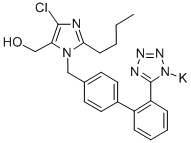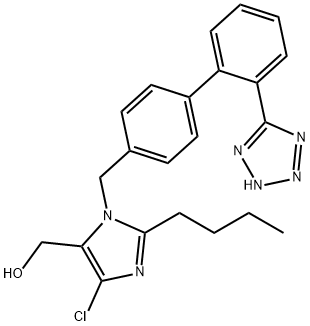Description
As a angiotensin II receptor antagonist, Losartan Potassium is the
potassium salt of losartan with antihypertensive activity, which is
mainly used in the therapy of high blood pressure (hypertension) and
diabetic nephropathy. It functions by relaxing blood vessels so that
blood can flow more easily. It is also effective to help protect the
kidneys from damage caused by diabetes and lower the risks of stroke
in patients suffering from hypertension and myocardial enlargement.
Besides, recent study has suggested that losartan is beneficial to
reverse age related dysfunction in maintaining normal blood pressure
and cellular energy usage on mitochondria and it can probably be
used to treat left ventricular hypertrophy. It may also be used as
an alternative agent for the treatment of systolic dysfunction,
myocardial infarction, coronary artery disease, and heart failure.
References
https://en.wikipedia.org/wiki/Losartan
https://www.drugbank.ca/drugs/DB00678
https://pubchem.ncbi.nlm.nih.gov/compound/11751549#section=Top
http://www.medicinenet.com/losartan-oral/article.htm
Description
Angiotensin II is a hormone that plays an important role in regulating blood pressure. Elevated levels of angiotensin II are implicated in inducing and maintaining hypertension, and also in the development of atherosclerosis. Both of these effects are mediated by the angiotensin II type 1 (AT
1) receptor. Losartan is an AT
1 receptor antagonist with a K
i value of 5-
20 nM. It has an attenuating effect on vein graft atherosclerosis in rabbits and effectively reduces arterial blood pressure in rats. In humans, losartan controls hypertension while protecting renal function.
Description
Losartan potassium is the first potent and selective non-peptide angiotensin II
(AT II) AT
1 receptor antagonist introduced to the market as a once-daily oral
antihypertensive. It is efficacious and long lasting in controlling blood pressure in
spontaneous hypertensive rats, in patients with essential hypertension in addition to
those patients with renal impairment. Since losartan functions by competitive
antagonism at the level of receptor, which represents the most direct way of
selectively inhibiting the renin-angiotensin system (RAS) independent of the source
of AT II, its use has been reported to be free of the coughing side effect exhibited by
the ACE inhibitors. In contrast to calcium channel blockers, losartan does not
appear to cause ankle edema, headache and tachycardia. It is also reported to be in
clinical trials for the treatment of heart failure. Other reports indicate that losartan
may have potential efficacy as an anxiolytic, an antiglaucoma agent, in addition to in providing protection against stroke and in preventing the myointimal proliferative
response of the vascular wall after coronary angioplasty and surgery.
Chemical Properties
White to Off-White Crystalline Powder
Originator
DuPont Merck (U.S.A.)
Uses
antihypertensive, AT1 angiotensin II antagonist
Uses
A nonpeptide angiotensin II AT1-receptor antagonist. Antihypertensive.
Uses
Coronary vasodilator used in the diagnosis of coronary heart disease (adenosine A2A agonist).
Manufacturing Process
2-Butyl-4-chloro-1-(2'-(tetrazol-5-yl)biphenyl-4-ylmethyl)-1H-imidazole-5- methanolpotassium was synthesized in 5 stages.
1. Methyl 4'-methylbiphenyl-2-carboxylate (44.2 mmol), 0.5 N KOH in methanol (133 mmol), and water (50 mL) were mixed and refluxed under nitrogen. After 5 hours, the solvent was removed in vacuo and water (200 mL) and ethyl acetate (200 mL) added. The aqueous layer was acidified with concentrated hydrochloric acid to a pH of 3 and the layers were separated. The aqueous phase was extracted with ethyl acetate, the organic layers collected, dried (MgSO4) and the solvent removed in vacuo to yield 8.71 g of a 4'-methylbiphenyl-2-carboxylic acid, melting point 140.0-145.0°C.
2. 4'-Methylbiphenyl-2-carboxylic acid (41 mmol) and thionyl chloride (411 mmol) were mixed and refluxed for 2 hours. The excess thionyl chloride was removed in vacuo and the residue was taken up in toluene. The toluene was removed by rotary evaporation. The crude acid chloride was then added slowly to cold (0°C) concentrated NH4OH (50 mL) so that the temperature was kept below 15°C. After 15 minutes of stirring, water (100 mL) was added and solids precipitated. These were collected, washed with water and dried under high vacuum over P2O5 to yield 7.45 g of a white solid, melting point 126.0-128.5°C. The above product amide (35 mmol) and thionyl chloride (353 mmol) were mixed and refluxed for 3 hours. The thionyl chloride was removed using the same procedure as described above. The residue was washed with a little hexane to yield 6.64 g of 4'-methyl-2-cyanobiphenyl, melting point 44.0- 47.0°C.
3. 4'-Methyl-2-cyanobiphenyl (5.59 g) was brominated using benzoyl peroxide as an initiator. The product was recrystallized from ether to yield 4.7 g of 4'- bromomethyl-2-cyanobiphenyl, melting point 114.5-120.0°C.
4. 4'-Bromomethyl-2-cyanobiphenyl (4.6 g) was alkylated onto 2-n-butyl-4-
chloro-5-(hydroxymethyl)-imidazole. For separation of the product was used a
flash chromatography in 1:1 hexane/ethyl acetate over silica gel. The
regioisomeric products yielded 2.53 g of the faster eluting isomer.
Recrystallization from acetonitrile yielded 1.57 g of analytically pure 2-n-butyl4-chloro-1-[2'-cyanobiphenyl-4-yl)methyl]-5-(hydroxymethyl)-imidazole,
melting point 153.5 -155.5°C.
5. 2-n-Butyl-4-chloro-1-[(2'-cyanobiphenyl-4-yl)-methyl]-5-(hydroxymethyl)-
imidazole (10 mmole), sodium azide (10 mmol), and ammonium chloride (30
mmol) were mixed in DMF (150 mL) under N2 at 100°C for 2 days, after
which the temperature was raised to 120°C for 6 days. The reaction was
cooled and 3 more equivalents each of ammonium chloride and sodium azide
were added. The reaction was again heated for 5 days at 120°C. The reaction
was cooled, the inorganic salts filtered, and the filtrate solvent removed in
vacuo. Water (200 mL) and ethyl acetate (200 mL) were added to the residue
and the layers were separated. The aqueous layer was extracted with ethyl
acetate, the organic layers were collected, dried (MgSO4) and the solvent
removed in vacuo, to yield a dark yellow oil. The product was purified by flash
chromatography in 100% ethyl acetate to 100% ethanol over silica gel to
yield 5.60 g of a light yellow 2-n-butyl-4-chloro-5-hydroxymethyl-1-[(2'-(1Htetrazol-5-yl)biphenyl-4-yl)methyl]imidazole. Recrystallization from acetonitrile
yielded 4.36 g of light yellow crystals which still melted broadly. The crystals
were taken up in 100 mL of hot acetonitrile. The solid that did not dissolve
was filtered off to yield 1.04 g of product as a light yellow solid, melting point
of 2-n-butyl-4-chloro-5-hydroxymethyl-1-[(2'-(1H-tetrazol-5-yl)biphenyl-4-
yl)methyl]imidazole 183.5-184.5°C.
2-n-Butyl-4-chloro-5-hydroxymethyl-1-[(2'-(1H-tetrazol-5-yl)biphenyl-4-
yl)methyl]imidazole may be converted to potassium salt.
brand name
Cozaar (Merck).
Therapeutic Function
Antihypertensive
Biological Activity
Selective non-peptide angiotensin AT 1 receptor antagonist. Inhibits the contractile effects of angiotensin II on rabbit aorta and jugular vein (pA 2 = 8.27). Orally active antihypertensive agent.
References
1) Merck 14:5583
2) Chiu et al. (1990), Nonpeptide angiotensin II receptor antagonists. VII. Cellular and biochemical pharmacology of DuP 753, an orally active antihypertensive agent; J. Pharmacol. Exp. Ther., 252 711
3) McIntyre et al. (1997), Losartan, an orally active angiotensin (AT1) receptor antagonist: a review of it’s efficacy and safety in essential hypertension; Pharmacol. Ther., 74 181
4) Diop-Frimpong et al. (2011), Losartan inhibits collagen I synthesis and improves the distribution and efficacy of nanotherapeutics in tumors; Proc. Natl. Acad. Sci. USA, 108 2909
5) Pantazi et al. (2015), Losartan activates sirtuin 1 in rat reduced-size orthotopic liver transplantation; World J. Gastroenterol., 21 8021
6) Kumar et al. (2015), Neuroprotective mechanism of losartan and its interaction with nimesulide against chronic fatigue stress; Inflammopharmacology, 23 291
7) Miguel-Carrasco et al. (2017), Mechanisms underlying the cardiac antifibrotic effects of losartan metabolites; Sci. Rep. 7 41865





